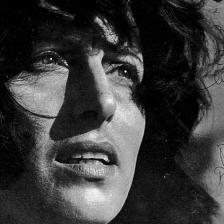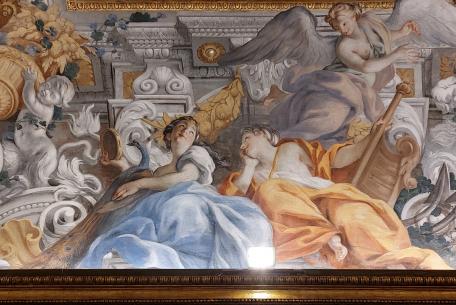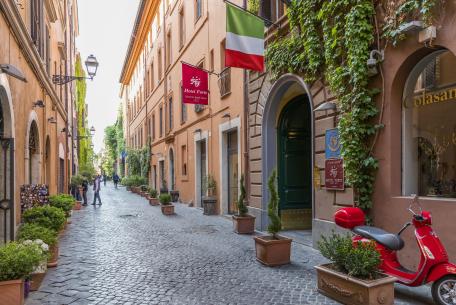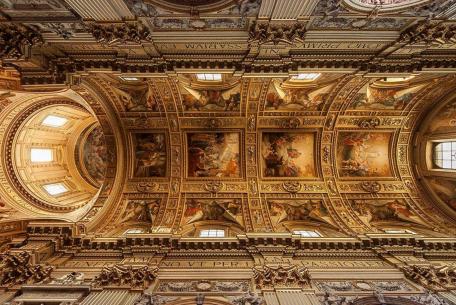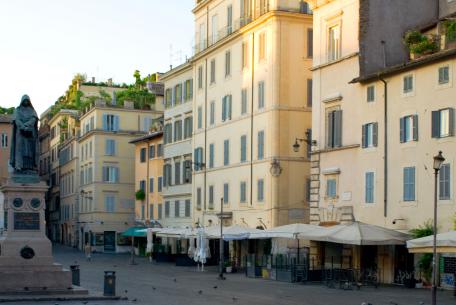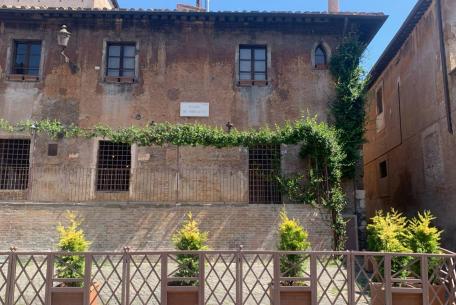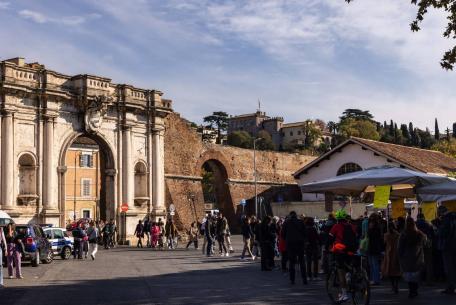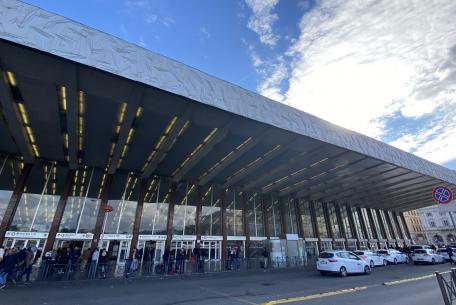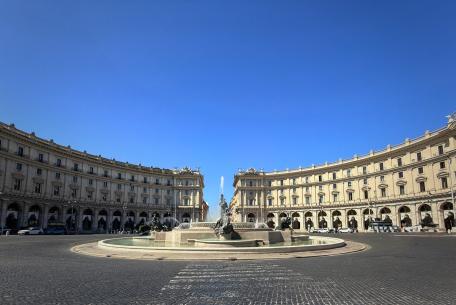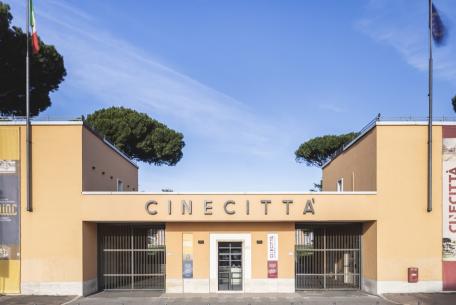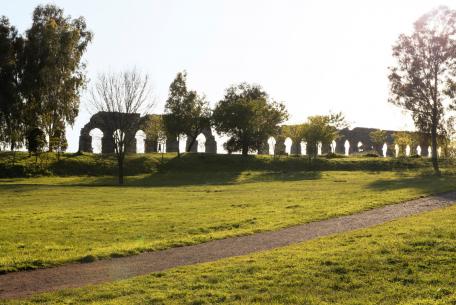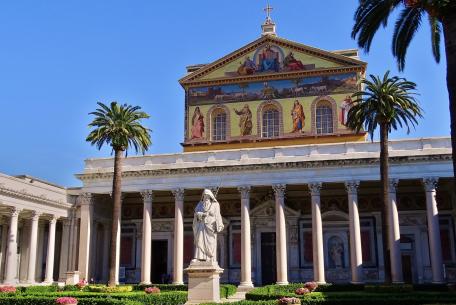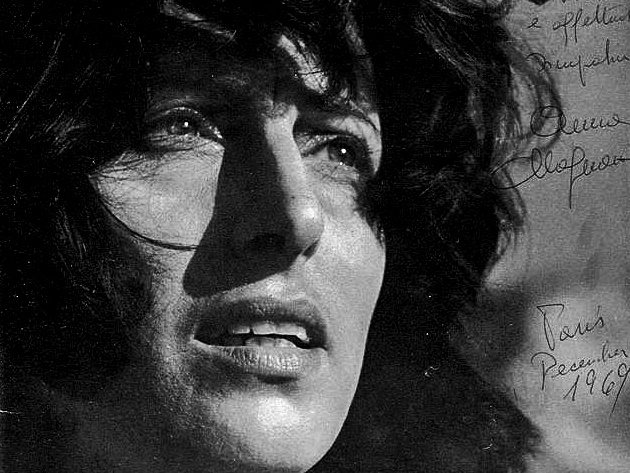
Among women, Anna Magnani is considered one of the greatest performers in the history of cinema.
She was born in Rome on 7th March 1908. Her mother, Marina Magnani, entrusted her to her maternal grandmother and moved to Alexandria, Egypt. Little Anna grew up with her grandmother in Via di San Teodoro, in the heart of Rome, between the Capitoline Hill and the Palatine Hill. When she later discovered that her father's name, who had never recognized her, was Pietro Del Duce, she declared, with a veil of irony, that she did not want to be the 'daughter of Del Duce' (TN. A play on words also referring to Duce Mussolini).
As a child she began studying the piano at the Accademia di Santa Cecilia, but abandoned it for acting. In 1926 she was admitted to the “Reale Scuola di Recitazione Eleonora Duse”. Among the examiners was Silvio D'Amico, who immediately sensed that she had outstanding acting skills. She left the school halfway through her second year to begin her theatre career. Various companies engaged her until she started acting in light theatre, where she could put her qualities into action: passion, boldness, elegance, and musicality.
Anna Magnani made her debut in cinema in 1934 with the film La cieca di Sorrento, by Nunzio Malasomma, but was disappointed, while the theatre continued to give her great satisfaction. The comic characters Gagà and Gagarella, were born collaborating with the great actor Totò in the revue show (an evolution of variety theatre), Quando meno te l'aspetti (1940) by Michele Galderi. She starred alongside Aldo Fabrizi and Peppino de Filippo in Mario Bonnard's Campo de' Fiori (1943). Anna Magnani won her first Silver Ribbon and achieved worldwide fame thanks to Roberto Rossellini's Roma città aperta (1945). Masterful interpretations followed, such as in Luigi Zampa's L'onorevole Angelina (1947) and Rossellini's two-episode film L'amore (1948). In 1949 she played the role of Maddalena in the film Vulcano (1950) directed by William Dieterle. Successes and awards followed. She won her fourth Silver Ribbon by starring in Luchino Visconti's Bellissima (1951). She won the Oscar for Best Actress in a Leading Role (the first non-English speaking actress to receive the award) for The Rose Tattoo (1955), a film by Daniel Mann.
In 1958, in addition to international recognition at the Berlin Film Festival as best actress for her role in George Cukor's Wild is the Wind (1957), she also won her first David di Donatello. She continued to play comic (and bitter) roles, such as in Mario Monicelli's Risate di gioia (1960), which brought the extraordinary Totò-Magnani duo to the big screen, as well as more dramatic ones such as in Pier Paolo Pasolini's Mamma Roma (1962). Always in love with the theatre, she returned to it with La lupa (1965) by Giovanni Verga, directed by Franco Zeffirelli, and with Medea (1966) by Jean Anouilh, directed by Gian Carlo Menotti.
Nannarella, as everyone used to call her, died on 26 September 1973 at the age of 65.
City Centre
Palazzo Altieri
Via degli Astalli, 19
Historical residence of the Altieri family, including Cardinal Emilio Altieri, who later became Pope Clement X in 1670. Anna Magnani lived for about twenty years in a penthouse of this 17th-century building.
Via Margutta 51
Roma città aperta, Roberto Rossellini (1945)
Don Pietro (Aldo Fabrizi) carries out the mission entrusted to him by Manfredi (Marcello Pagliero), a Communist leader involved in the Resistance and wanted by the Gestapo, to collect a sum destined for a partisan group from the clandestine printing house of 'l'Unità' newspaper and deliver it to another intermediary.
Via Borgognona
Bellissima, Luchino Visconti (1951)
This is the street where Alberto Annovazzi (Walter Chiari) picks up the Lambretta he bought with the 50,000 lire he had asked Maddalena (Anna Magnani) to 'guarantee' that her daughter would pass the audition for Alessandro Blasetti's film.
Basilica di Sant’Andrea della Valle
Piazza Vidoni, 6
Risate di gioia, Mario Monicelli (1960)
One of the final scenes of the film, in which Gioia (Anna Magnani) and Umberto (Totò), after being chased out of the villa by the Germans, take shelter in the church because of a sudden storm. On this occasion Gioia discovers that Lello (Ben Gazzara) has just stolen a necklace from the statue of the Madonna.
Campo de' Fiori
Campo de’ Fiori, Mario Bonnard (1943)
The scene takes place in front of the fountain in Campo de' Fiori. It is one of the many quarrels and squabbles between the vegetable seller Elide (Anna Magnani) and the fishmonger Peppino (Aldo Fabrizi) while Sora Peppa, the concierge (Olga Capri), arrives carrying the little Carletto in her arms (Cristiano Cristiani).
Piazza dei Mercanti (Trastevere)
Mamma Roma, Pier Paolo Pasolini (1962)
Using a trick, Mamma Roma (Anna Magnani) gets Mr Pellissier (Vittorio La Paglia), the owner of a trattoria in Trastevere (now a famous restaurant), to employ her son as a waiter. Together with her accomplice Biancofiore (Luisa Loiano), she proudly observes Ettore (Ettore Garofolo) as he is serving tables in the trattoria and is moved.
Porta Portese
Mamma Roma, Pier Paolo Pasolini (1962)
Ettore (Ettore Garofolo), unbeknownst to his mother, is selling some records, including Violino Tzigano, to “Gennarino il Trovatore” (Emanuele di Bari), in Porta Portese market just renowned. The façade of the San Michele a Ripa Grande compound, housing the juvenile prison, and a glimpse of the Altare della Patria can be seen in the background.
Porto di Ripa Grande
Risate di gioia, Mario Monicelli (1960)
Gioia (Anna Magnani), still wearing her New Year's Eve clothes, comes out of prison on the day of Ferragosto (mid-August) and finds Umberto (Totò) waiting for her. Caught up in the euphoria, while imagining their future in the cinema, they call a taxi but get off a few metres later in front of the steps of Porto di Ripa Grande.
Stazione Termini
L’ultima carrozzella, Mario Mattoli (1943)
The singer-songwriter Mary Dunchetti arrives at Termini station aboard the carriage of Roman coachman Antonio Urbani, known as Toto (Aldo Fabrizi). Designed by Salvatore Bianchi in 1867, the façade of the old station can be spotted at Piazza dei Cinquecento. The modern Station was inaugurated in 1950, characterized by a bold canopy designed by six architects led by Annibale Vitellozzi and Eugenio Montuori and called the “Dinosaur” because of its shape.
Piazza della Repubblica
Risate di gioia, Mario Monicelli (1960)
Gioia (Anna Magnani) is waiting, in vain, for her friends with whom she is to spend New Year's Eve, in front of the Fountain of the Naiads. In fact, 'her friends' have just realized that there will be thirteen of them with Gioia at the New Year's Eve party, they give in to superstition and decide to leave her alone. While Gioia is waiting, she sees an elegant, slightly tipsy tourist get out of a car, approach the fountain, and throw a coin, thinking he is standing in front of the Trevi Fountain.
Pigneto
Via Montecuccoli
Roma città aperta, Roberto Rossellini (1945)
While desperately screaming and chasing the truck on which her beloved Francesco (Francesco Grandjacquet) has been deported, Pina (Anna Magnani) is shot to death by Nazi machine guns. She dies in the arms of Don Pietro (Aldo Fabrizi), while her son cries out in pain.
Circonvallazione Casilina
Roma città aperta, Roberto Rossellini (1945)
This is the street where Pina (Anna Magnani) confesses to Don Pietro (Aldo Fabrizi) about her past and tells him that she is worried about marrying Francesco, younger than her, who is a widow and has a son.
Casal Bertone
Mamma Roma, Pier Paolo Pasolini (1962)
This is the house where Mamma Roma (Anna Magnani) lives with her son Ettore (Ettore Garofolo), before giving up street life and moving to an apartment on the outskirts of Rome. It is the Palazzo dei Ferrovieri (Railway workers building), in Piazza Tommaso de Cristoforis, a clear example of social housing from the late 1920s, also known as "dei due cervi" (the two deer building), depicted above the main entrance.
Cinecittà
Cinecittà Studios
Bellissima, Luchino Visconti (1951)
Maddalena Cecconi (Anna Magnani) takes little Maria (Tina Apicella) to the Cinecittà Studios where auditions are being held to find a little girl actress for Alessandro Blasetti's film. She is willing to do anything to make her daughter pass the audition.
Via Appia Nuova
Mamma Roma, Pier Paolo Pasolini (1962)
Mamma Roma and Ettore (Ettore Garofolo) take a ride on their newly purchased motorcycle through the streets of the Tuscolano district, from which the ruins of the Parco degli Acquedotti can be seen. Mamma Roma moved to a social housing flat in this district to change her life and to offer a better future to her son.
Lucio Sestio
Mamma Roma, Pier Paolo Pasolini (1962)
After moving into the new neighborhood, Mamma Roma (Anna Magnani) opens her fruit and vegetable stall. This scene also shows the Parco degli Acquedotti in the background, not far from the Cinecittà Studios.
Parco degli Acquedotti
Mamma Roma, Pier Paolo Pasolini (1962)
Ettore (Ettore Garofolo), together with other boys from the neighbourhood, meets Bruna (Silvana Corsini) near the ruins of Villa delle Vignacce, so called probably because of the amphorae known as 'pignacce', still visible in the vaults. Shortly afterwards, he returns to the same place. This time he is alone and improvises a balancing act under the amused gaze of three girls.
Ostiense
Basilica di San Paolo fuori le mura
Bellissima, Luchino Visconti (1951)
Maddalena Cecconi (Anna Magnani) and little Maria (Tina Apicella) go home full of hope after their audition at Cinecittà Studios. The Basilica of St Paul Outside the Walls stands out in the background.
Stazione Piramide Linea B Metropolitana
Risate di gioia, Mario Monicelli (1960)
Gioia (Anna Magnani) gets into the underground station together with Umberto (Totò) and Lello (Ben Gazzara), who, in order to get rid of her, uses subterfuge to make her take the underground in the wrong direction.
Much-loved places
Circeo
At the end of the 1940s, after the shooting of the film Vulcano (William Dieterle), Anna Magnani bought land at Circeo as she was in love with this wild rugged place. Here she had her beautiful villa built, with special access to the sea, taking care of every single detail.
 Condividi
Condividi












































